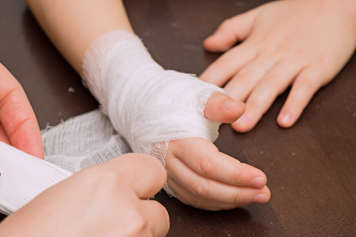Some wounds need to be repaired by a health-care provider in a hospital or clinic. This information will help you care for your child’s wound at home after it is repaired.
How was the wound repaired?
It is important to know what was used to repair a wound. Ask your child's health-care provider how the wound was repaired. This may include:
- regular stitches (including the number of stitches and when they should be removed)
- stitches that dissolve (including the number of stitches)
- staples (including the number of staples and when they should be removed)
- glue
- adhesive strips (Steri-Strips)
- no repair or closure was required
Caring for a wound with stitches (regular or dissolving) or staples
Keep the wound covered, clean and dry. Keep your child’s wound completely covered with a bandage until a scab has formed. After that, you may want to put a bandage on to protect the wound during activities but leave it off and leave the wound open to the air when your child is resting or in quiet activity at home. Do not let your child play with or pull on the stitches. If the stitches are on an arm or leg, raising the arm or leg will keep your child more comfortable.
Depending on the instructions that you have been given, you may need to change the bandage one or two times a day. To change the bandage, you need to remove the soiled bandage and apply a fresh one. While most wounds do not require any ointment, you may be given specific advice form your child's health-care provider to use an ointment, such as an antibiotic ointment.
If you are advised to use antibiotic ointment, avoid contamination by making sure not to touch the opening of the tube with a dirty finger or by applying the tube directly to the wound. Instead, squeeze the cream directly onto a clean cotton swab or cotton ball and then use this to apply it to the wound.
Washing the wound
Once a scab has formed (usually after 24 to 48 hours), you can gently wash the wound with mild soap and water one or two times each day. Do not rub or soak the wound. Do not use alcohol or hydrogen peroxide.
Bathing
Do not give your child a bath if the wound will go under water. It may be easier to have your child stand up in the bathtub or shower and use a damp towel to wash the non-wounded parts of the body. A shower is another bathing option while the wound is healing.
Protecting the stitches or staples
Your child should avoid contact sports and swimming until their wound has closed and their stitches or staples have been removed. This will give the wound the best chance to heal. Try to prevent your child from playing with sand, mud or paint near their wound as this could cause the wound to get dirty, which could lead to infection.
Removing stitches or staples
If your child’s wound was treated with regular stitches or staples, you will be told when they need to be removed. Removal can usually be performed by your child's regular health-care provider. If your child’s wound was treated with dissolving stitches, they do not need to be removed. They will dissolve, or melt away. This usually occurs after about a week but may take up to several weeks.
Caring for a wound treated with glue
The glue should peel or fall off between five and 14 days after it is applied.
There is no need to cover the wound with a bandage, but some parents may put a bandage over the wound to prevent the child from picking at the glue. Avoid using a bandage that could remove the glue if the bandage comes off. Your child does not need to see the doctor after the glue has peeled or fallen off.
Bathing
You should try to keep the wound dry for at least five days. After that, it is fine to wash the wound, but do not soak it in water for a long time. Do not give your child a bath if the wound will be under water. It may be easier to have your child stand up in the bathtub or shower and use a damp towel to wash the non-wounded parts of the body. A shower is another bathing option while the wound is healing. After the shower, the wound should be patted dry with a towel. Your child should not swim while the glue is still in place.
Protecting the wound and glue
Do not pick or scratch the wound or the glue. Pat the wound dry and do not rub it. Avoid wearing tight clothing that could rub against the wound. Do not apply any creams or ointments to the wound until the glue peels or falls off. Applying creams or ointments may make the glue come off too soon.
Caring for your child’s wound treated with adhesive strips (Steri-Strips)
You can trim the edges of the strips as they naturally separate from the skin with time. If the strips remain in place after seven days, you can remove them at home by soaking them in water.
Bathing
Keep the wound and adhesive strips dry for the first 24 hours. Then, you can gently wash the wound with soap and water and then pat it dry. Do not soak or rub the wound. Your child can have a shower, after which the wound can be patted dry with a towel. Your child should not swim with adhesive strips.
Occlusive dressings
Sometimes, your child's health-care provider may suggest using a special layered dressing called an occlusive or semi-occlusive dressing. This type of dressing keeps the healing area moist and helps to promote the growth of new skin cells. It consists of:
- a base or "contact" layer that will not stick to the wound (non-adherent)
- an absorbent layer to absorb any fluid or blood
- an outer layer to anchor the dressing and provide some pressure, if needed
You can buy these layers at the pharmacy. Some adhesive bandages provide all three layers in one.
To change a layered dressing, you should usually leave the contact layer in place. Change the absorbent and outer layers every day, or more often if the dressing becomes dirty or wet. When changing the contact layer, remove it carefully so as to not disrupt the healing skin.
Taking care of your child’s scar after the wound has healed
Most wounds will leave some degree of a scar on the skin. Scar formation is affected by many factors, such as wound location and size, skin type, age, infection, smoking and current diseases or skin conditions. Your child’s scar may appear thick for the first few months after repair. The appearance of the scar will continue to change during the first six to 18 months after the wound is repaired.
Once the wound is repaired, you can help minimize the final appearance of the scar by doing the following:
- Protect your child’s scar from direct sunlight. Cover the wound with clothing, stay in the shade and use protective sunblock.
- Gently apply a moisturizer cream, such as a Vitamin E cream, to the scar one or two times a day for about four to six weeks after the wound is repaired. Do not apply moisturizer if the staples, stitches, glue or strips are still on the wound.
When to see a health-care provider
As your child’s wound heals, the edges will become slightly pink. This is normal.
It is important to watch for any signs of infection. Take your child to a health-care provider if any of the following happen:
- Your child’s wound becomes painful, red or swollen.
- There is a yellowish or greenish fluid coming from your child’s wound.
- Your child develops a fever along with any of the symptoms listed above.
- Your child’s wound opens up or starts bleeding.

